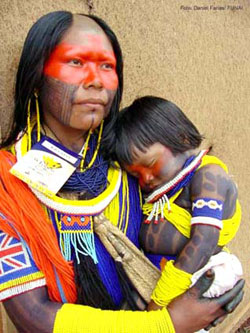Unknown tribe found in the Amazon
Unknown tribe found in the Amazon
mongabay.com
June 4, 2007 [updates]
An unknown Indian tribe has been discovered in the Amazon rainforest reports the Associated Press.
The Metyktire tribe, with about 87 members, was found in late May around 1,200 northwest of Rio de Janeiro. Brazil’s Federal Indian Bureau (FUNAI) says the tribe is a subgroup of the Kayapo tribe and lives on the Kayapos’ 12.1-million-acre Menkregnoti Indian reservation.
Two Metyktire tribe members appeared in a Kayapo village. It is unclear why they established contact with the Kayapo but a medical team has been allowed access to the isolated group.
The Indigenous People’s Cultural Support Trust in London, a nonprofit group working in the area, reports in a blog entry that Metyktire speak an archaic version of the Kayapo language. Men are naked except for penis sheathes and large lip-plates, while females shave the top of their heads.
 Kayapo woman and child. Photo by Daniel Farias / FUNAI |
Survival International estimates there are more than 100 uncontacted tribes around the world, most of whom live in the Amazon rainforest.
In Brazil there are some 700,000 Indians, of whom 450,000 lives on indigenous reserves which cover 12.5% of the country and 26% of the Brazilian Amazon. The size of Indian territories is almost double the size of all state and federal protected areas. Research published last year by scientists at the Woods Hole Research Center and the Instituto de Pesquisa Ambiental da Amazonia showed that indigenous reserves in the Amazon help slow deforestation and reduce the incidence of fire.
The Amazon has lost about 700,000 square kilometers (270,000 square miles) of forest since the early 1970s, though deforestation has slowed in recent years due to economic trends and government efforts.
Related
Photos of spear-wielding uncontacted tribe in the Amazon rainforest (May 30, 2008) A fly-over of a remote part of the Amazon rainforest spotted members of what is believed to be one of the world’s last uncontacted tribes. The Amazonians reacted aggressively to the fly-over, with bow and arrows aimed at the plane, according to Survival International, a group that works to protect indigenous peoples.
Unknown tribe found in the Amazon (June 4, 2007) An unknown Indian tribe has been discovered in the Amazon rainforest reports the Associated Press. The Metyktire tribe, with about 87 members, was found in late May around 1,200 northwest of Rio de Janeiro. Brazil’s Federal Indian Bureau (FUNAI) says the tribe is a subgroup of the Kayapo tribe and lives on the Kayapos’ 12.1-million-acre Menkregnoti Indian reservation.
Ancient Amazonian technology could save the world (May 17, 2007) Terra preta, the ancient charcoal-based soil used by ancient Amazonians to create permanently fertile agricultural lands in the rainforest, is getting serious consideration as a means to fight global warming and meet domestic energy demand, reports an article in Scientific American.
Amazon natives use Google Earth, GPS to protect forest home (November 14, 2006) Deep in the most remote jungles of South America, Amazon Indians (Amerindians) are using Google Earth, Global Positioning System (GPS) mapping, and other technologies to protect their fast-dwindling home. Tribes in Suriname, Brazil, and Colombia are combining their traditional knowledge of the rainforest with Western technology to conserve forests and maintain ties to their history and cultural traditions, which include profound knowledge of the forest ecosystem and medicinal plants. Helping them is the Amazon Conservation Team (ACT), a nonprofit organization working with indigenous people to conserve biodiversity, health, and culture in South American rainforests.
Amazon Stonehenge suggests advanced ancient rainforest culture (May 14, 2006) The discovery of an ancient astrological observatory in Brazil lends support to the theory that the Amazon rainforest was once home to advanced cultures and large sedentary populations of people. Besides the well-known empires of the Inca and their predecessors, millions of people once lived in the forests and shaped the environment to suit their own needs.